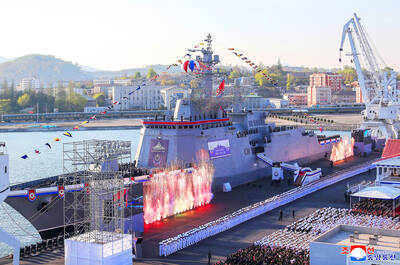Like generations of Tibetan nomads before him, Phuntsok Dorje makes a living raising yaks and other livestock on the vast alpine grasslands that provide a thatch on the roof of the world.
However, in recent years the vegetation around his home, the Tibetan plateau, has been destroyed by rising temperatures, excess livestock and plagues of insects and rodents.
The high-altitude meadows are rarely mentioned in discussions of global warming, but the changes to this ground have a profound impact on Tibetan politics and the world’s ecological security.
For Phuntsok Dorje, the issue is more down to earth. He is used to dramatically shifting cloudscapes above his head, but it is the changes below his feet that make him uneasy.
“The grass used to be up to here,” Phuntsok said, indicating a point on his leg a little below the knee. “Twenty years ago, we had to scythe it down. But now, well, you can see for yourself. It’s so short it looks like moss.”
The green prairie that used to surround his tent has become a brown desert. All that is left of the grasslands here are yellowing blotches on a stony surface riddled with rodent holes.
It is the same across much of this plateau, which encompasses an area a third of the size of the US.
Scientists say the desertification of the mountain grasslands is accelerating climate change. Without its thatch the roof of the world is less able to absorb moisture and more likely to radiate heat.
Partly because of this the Tibetan mountains have warmed two to three times faster than the global average; the permafrost and glaciers of the “Third Pole” are melting.
To make matters worse, the towering Kunlun, Himalayan and Karakorum ranges that surround the plateau act as a chimney for water vapor — which has a stronger greenhouse gas effect than carbon dioxide — to be convected high into the stratosphere. Mixed with pollution, dust and black carbon (soot) from India and elsewhere, this spreads a brown cloud across swaths of the Eurasian landmass. When permafrost melts it can also release methane, another powerful greenhouse gas.
Beijing climate center director general Xiao Ziniu (肖子牛) says Tibet’s climate is the most sensitive in Asia and influences the globe.
Until about 10 years ago the nearest town, Maduo, used to be the richest in Qinghai Province thanks to herding, fishing and mining, but residents say their economy has dried up along with the nearby wetlands.
By one estimate, 70 percent of the former rangeland is now desert.
Many of the local people are former herders moved off the land under a controversial “ecological migration” scheme launched in 2003. The government in Beijing is in the advanced stages of relocating between 50 percent and 80 percent of the 2.25 million nomads on the Tibetan plateau. According to state media, this program aims to restore the grasslands, prevent overgrazing and improve living standards.
The Tibetan government-in-exile says the scheme does little for the environment and is aimed at clearing the land for mineral extraction and moving potential supporters of the Dalai Lama into urban areas where they can be more easily controlled.
Qinghai is dotted with resettlement centers, many on the way to becoming ghettos. Nomads are paid an annual allowance — of 3,000 yuan (US$440) to 8,000 yuan per household — to give up herding for 10 years and be provided with housing. As in some Native American reservations in the US and Canada, they have trouble finding jobs. Many end up either unemployed or recycling rubbish or collecting dung.
Some feel cheated.
“If I could go back to herding, I would. But the land has been taken by the state and the livestock has been sold off so we are stuck here. It’s hopeless,” said Shang Lashi, a resident at a resettlement center in Yushu. “We were promised jobs. But there is no work. We live on the 3,000 yuan a year allowance, but the officials deduct money from that for the housing, which was supposed to be free.”

Archeologists in Peru on Thursday said they found the 5,000-year-old remains of a noblewoman at the sacred city of Caral, revealing the important role played by women in the oldest center of civilization in the Americas. “What has been discovered corresponds to a woman who apparently had elevated status, an elite woman,” archeologist David Palomino said. The mummy was found in Aspero, a sacred site within the city of Caral that was a garbage dump for more than 30 years until becoming an archeological site in the 1990s. Palomino said the carefully preserved remains, dating to 3,000BC, contained skin, part of the

TRUMP EFFECT: The win capped one of the most dramatic turnarounds in Canadian political history after the Conservatives had led the Liberals by more than 20 points Canadian Prime Minister Mark Carney yesterday pledged to win US President Donald Trump’s trade war after winning Canada’s election and leading his Liberal Party to another term in power. Following a campaign dominated by Trump’s tariffs and annexation threats, Carney promised to chart “a new path forward” in a world “fundamentally changed” by a US that is newly hostile to free trade. “We are over the shock of the American betrayal, but we should never forget the lessons,” said Carney, who led the central banks of Canada and the UK before entering politics earlier this year. “We will win this trade war and

‘BODIES EVERYWHERE’: The incident occurred at a Filipino festival celebrating an anti-colonial leader, with the driver described as a ‘lone suspect’ known to police Canadian police arrested a man on Saturday after a car plowed into a street party in the western Canadian city of Vancouver, killing a number of people. Authorities said the incident happened shortly after 8pm in Vancouver’s Sunset on Fraser neighborhood as members of the Filipino community gathered to celebrate Lapu Lapu Day. The festival, which commemorates a Filipino anti-colonial leader from the 16th century, falls this year on the weekend before Canada’s election. A 30-year-old local man was arrested at the scene, Vancouver police wrote on X. The driver was a “lone suspect” known to police, a police spokesperson told journalists at the

North Korean leader Kim Jong-un has unveiled a new naval destroyer, claiming it as a significant advancement toward his goal of expanding the operational range and preemptive strike capabilities of his nuclear-armed military, state media said yesterday. North Korea’s state-run Korean Central News Agency (KCNA) said Kim attended the launching ceremony for the 5,000-tonne warship on Friday at the western port of Nampo. Kim framed the arms buildup as a response to perceived threats from the US and its allies in Asia, who have been expanding joint military exercises amid rising tensions over the North’s nuclear program. He added that the acquisition